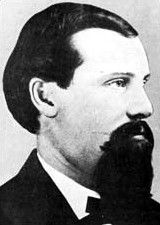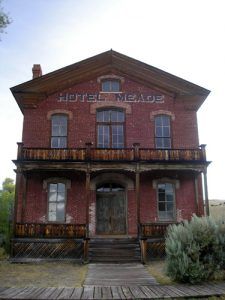LOCATION:
Brantley Mansion can be found in Helena, west-central Montana, built on Holter Street, sitting on top of a hill, which gives the mansion a full view of the city. Helena is 64 miles north of Butte on 1-15. The Mansion now is currently owned by a private party, so please respect their privacy.
Built in 1887, this grand, imposing mansion was created to impress the neighbors, with three floors, an attic, and a full basement. Inside, oak was extensively used throughout the interior. A main staircase wound majestically up toward the second and third floors. The dining room held a magnificent, built-in breakfront, fitted with lead glass doors. Sometime during its long history, each of the 4 floors, (including the basement), was converted into an apartment, dividing this grand mansion into 4 separate units. The attic was partially sealed off, and not used.
This stately, majestic mansion was originally the dream home of Judge Brantly, his wife, and three children, and was owned by the Brantly family until 1963. In 1887, Judge Brantley was a successful, self-made man, who was much admired by his community. The one big fault of this consciencious man was that he was a work-a-holic, who made little time for his family. He often came home after the children were in bed, and often brought work home with him.
In 1970, Bob and Dorthy and their three children bought the property, with plans to rennovate the old mansion, and make it into their family dream home.
The occurances started when the third floor was gutted and turned into the family living space. Dorthy started to feel the unrest in the house.
1) Both Dorthy and the kids heard at different times the big, heavy, front door open, and slam shut. Then foot steps would be heard traveling up the main staircase, all the way to the third floor, stopping to open doors along the way, as if someone was checking to see if all was well. ( Judge Brantly used to come home late at night when all were sleeping.)
2) Above Bob & Dorthy's bedroom, they would be awakened by someone thoughtfully pacing back and forth. Bob found a false wall in the closet, where a staircase once was, which led up to the sealed, attic room, located above their bedroom. This attic room was Judge Brantly's private study, where he thought about the cases that were being heard by him in his courtroom. (He was known to work at home often.)
3) Poltergeist activity was also experienced by both Bob & Dorthy & kids and their basement apartment tenant. The following incidents happened several times.
a) After a family ride in the car, they all came home to find their T.V. on full blast, and all the lights blazing away in the two boys' room.
b) Their basement tenant had the problem of having her candy all disappear, without eating any of it. The dish would be full one minute, and empty the next, too fast for human consumption. (Was a ghost with either a sweet tooth or a health agenda to be blamed?)
4) After Bob and Dorthy moved out because children were in college, the new caretaker and his wife looked in amazement as one of their potted plants went floating slowly through the air, and then suddenly dropped on the floor, breaking the pot, and killing the plant. Then, the vacuum cleaner turned on by itself and was moved by some guilty, unseen party, with a conscience, to clean up the dirty mess.
They also reported that some of the same occurrances recounted above, as happening to them.
It is assumed that at least one ghost, Judge Brantly, is an unseen resident here. He became active when rennovations started on his beloved home, and when a family much like his own moved in. No known psychic research has been done on the mansion, so no one knows for sure. No seen apparition has been reported, just the actions of one, (or more?) unseen restless one(s).
Caretakers and tenants alike still hear the footsteps of the stern spirit of State Supreme Court Judge Theodore Brantly going up the staircase to the third floor. Children still feel his presence watching over them. Caretakers and tenants have clearly indentified the ghostly entitiy of the good judge as the one who has a weakness for M & M candies, and will help himself to the candy if it is left out in a dish. Some ghosts like wine, some like tea, and this one has a sweet tooth!
Read more >>






